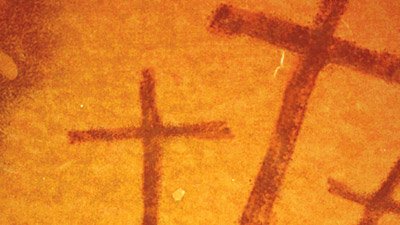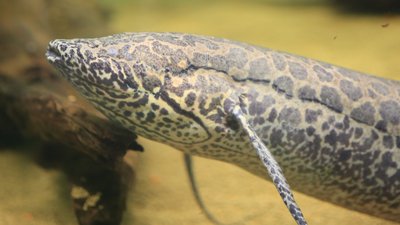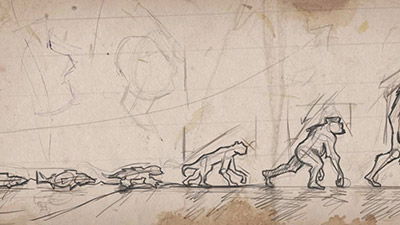Fish-to-Tetrapod Missing Link Found
According to a much-ballyhooed report in Nature, scientists have found another fish-to-tetrapod “missing link.” Just don’t read the fine print.
News Source
- National Geographic News: “Fishy Ancestors of Humans Surprisingly Diverse”
- BBC News: “Fossil Fills out Water–Land Leap”
A group of researchers headed by Professor Per Ahlberg from Uppsala University in Sweden has put their heads together—or at least, skulls and other fossils—and announced that an animal first unearthed in 1994, Ventastega curonica, “gives us clues to what the very earliest tetrapods looked liked.” The animal would likely have been aquatic and looked similar to a small alligator with a tail fin and a gill flap.
The real news according to reports, however, is that Ventastega is a transitory species, representing “an evolutionary midpoint between Tiktaalik . . . and primitive four-legged land animals.” The most recent specimens are said to give a clear portrait of an animal that has a hybrid fish-tetrapod skull and a “full-fledged tetrapod body.”
According to Professor Ahlberg:
Ventastega fills the gap between Tiktaalik and the earliest land based mammals. All these changes in these creatures are not going in lockstep; it’s a mosaic with different parts of animal evolving at different rates. Ventastega has acquired some of land-animal characteristics, but has not yet got some of the other ones.
Ventastega is a transitory species, representing “an evolutionary midpoint between Tiktaalik . . . and primitive four-legged land animals.”
That’s it then: case closed on fish evolving into land animals. Or is it? It is interesting that the authors would suggest that Ventastega is a “midpoint” between the fish Tiktaalik and land animals, since this is not entirely accurate—even using their own framework. In fact, according to the BBC News report, “Ventastega is a later species [than Tiktaalik] but is a more primitive animal.” Setting aside the arbitrary application of “primitive,” it is interesting that something hailed as transitional would be, by the author’s own estimation, a step backwards of sorts. After all, Ventastega was a dead-end that went extinct. (If we use their framework, we could just as easily say that alligators, crocodiles, seals, sea lions, crabs, and turtles represent transitional species, since they have features that allow them to live in and out of the water—never mind that they are well suited for their particular environments.)
So, even though the reports have headlines proclaiming that this new find fills out gaps and represents “human ancestors,” the articles themselves do not bear out these claims. Instead, the facts (the fossils) are nearly lost in the pontification (evolutionary assumptions). The researchers approach Ventastega with the assumption that evolution of sea to land animals occurred, and this new species, according to National Geographic News, “in many ways fulfills scientists’ expectations of what an early water-land transition animal should look like” (emphasis added). In other words, they had a preconceived notion and found what they wanted to find, even despite some morphological surprises (which they did acknowledge, but then used the unexpected morphology to suggest a fix for another evolutionary problem). As Dr. Ted Daeschler, a paleontologist at the Academy of Natural Sciences in Philadelphia, says, “It’s kind of remarkable that when we start to see true limbed animals, they’ve already diversified and are filling various special niches.” Indeed, it is amazing how the original created kinds diversified once after creation and again after the Flood.
The facts (the fossils) are nearly lost in the pontification (evolutionary assumptions).
What the scientists in this study did not do, was examine alternative ideas about what Ventastega represents. For example, if we start from the Bible—that God created the earth and all animal kinds in six days about 6,000 years ago, then we would likely conclude that Ventastega, like Tiktaalik, represents both the amazing creativity and economy that God has used in the multitude of diverse designs He made.
In his debunking of the “missing link” status of Tiktaalik, Dr. David Menton’s conclusion there is just as appropriate for Ventastega:
Sadly, “unfounded notions” of this kind continue to be uncritically taught and accepted in the popular media and in our schools. Even more sadly, these unfounded notions have been used to undermine the authority of Holy Scripture.
Further Reading
- Tiktaalik and the Fishy Story of Walking Fish, Part 2
- Yet Another ‘Missing Link’ Fails to Qualify
- The Fossil Record of ‘Early’ Tetrapods
- The Origin of Vertebrates [Evolution Exposed]
For More Information: Get Answers
Remember, if you see a news story that might merit some attention, let us know about it! (Note: if the story originates from the Associated Press, FOX News, MSNBC, the New York Times, or another major national media outlet, we will most likely have already heard about it.) And thanks to all of our readers who have submitted great news tips to us. If you didn’t catch all the latest News to Know, why not take a look to see what you’ve missed?
(Please note that links will take you directly to the source. Answers in Genesis is not responsible for content on the websites to which we refer. For more information, please see our Privacy Policy.)
Recommended Resources

Answers in Genesis is an apologetics ministry, dedicated to helping Christians defend their faith and proclaim the good news of Jesus Christ.
- Customer Service 800.778.3390
- © 2024 Answers in Genesis





